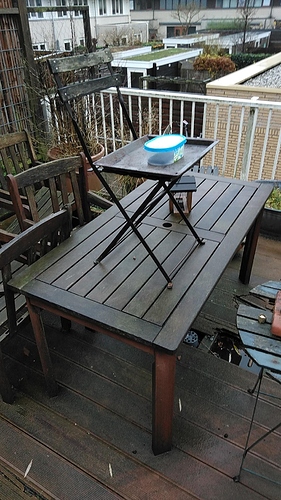Here my test results: My L5 has difficulties finding a GPS fix.
But in this setup it can easily get a fix (at the moment within ~ 15 seconds): The L5 is screen down in a this plastic container, I put this container on the metal baking plate of my oven. The metal plate with the plastic container is on top of a table which also has a stair on it, so that it is relative high on my terrace outside. The weather conditions are: a constant drizzle, so the plastic container and the baking plate from the oven are wet. The sky is completely covered with a light drizzle cloud layer.
When the oven baking plate is not there, I will not get a fix, when the oven plate is there, the L5 will get a fix.
I use these two commands to follow the progress of the fix via ssh, warm and dry from the inside of my house:
NOTE: running multiple socat commands in parallel on the unix-client:/var/run/gnss_share.sock seems to break things, so do NOT do that!
First I do:
sudo socat unix-client:/var/run/gnss_share.sock - | grep -aE --line-buffered '^\$G[P,L]GSV,.*'
This command shows all GPGSV and GLGSV sentences. From these sentences I can see if there are any satellites that have a signal/noise (s/n) value.
This is a typical example of these lines without s/n values (recognizable as the ,, values)
$GPGSV,3,1,11,13,77,298,,14,52,119,,05,49,215,,30,47,068,*71
$GPGSV,3,2,11,15,45,293,,20,25,190,,07,18,065,,18,16,299,*79
$GPGSV,3,3,11,23,10,325,,08,10,029,,24,06,248,,,,,*41
$GLGSV,3,1,09,76,75,065,,66,66,139,,67,56,316,,77,46,208,*6B
$GLGSV,3,2,09,75,20,038,,84,13,005,,83,09,309,,68,06,318,*67
$GLGSV,3,3,09,65,06,139,,,,,,,,,,,,,*52
With the oven baking plate under the plastic container, these lines change into lines that do contain an s/n value, like this:
$GPGSV,3,1,11,13,79,299,27,14,53,116,28,15,48,293,,05,48,213,*76
$GPGSV,3,2,11,30,45,068,28,20,23,189,,07,16,066,,18,15,297,*7C
$GPGSV,3,3,11,23,11,324,,08,09,027,,24,07,249,,,,,*47
$GLGSV,2,1,08,76,73,059,,66,63,141,,67,58,316,,77,49,209,*68
$GLGSV,2,2,08,75,18,039,,84,13,003,,68,08,319,,83,08,307,*6B
When I have lines with s/n values, I stop the command with CTRL-C and run:
sudo socat unix-client:/var/run/gnss_share.sock - | grep -aE --line-buffered '^\$GNGSA,[DANE],[1-3],[0-9]{2}'
This will then result in lines like:
$GNGSA,A,1,14,,,,,,,,,,,,99.0,99.0,99.0*1B
$GNGSA,A,1,14,,,,,,,,,,,,99.0,99.0,99.0*1B
$GNGSA,A,1,14,,,,,,,,,,,,99.0,99.0,99.0*1B
$GNGSA,A,1,14,,,,,,,,,,,,99.0,99.0,99.0*1B
$GNGSA,A,1,14,30,,,,,,,,,,,99.0,99.0,99.0*18
$GNGSA,A,1,14,30,,,,,,,,,,,99.0,99.0,99.0*18
$GNGSA,A,1,14,30,,,,,,,,,,,99.0,99.0,99.0*18
$GNGSA,A,1,14,30,,,,,,,,,,,99.0,99.0,99.0*18
$GNGSA,A,2,13,14,30,,,,,,,,,,4.3,4.1,1.0*2A
$GNGSA,A,2,13,14,30,,,,,,,,,,99.0,99.0,99.0*19
$GNGSA,A,2,13,14,30,,,,,,,,,,99.0,99.0,99.0*19
$GNGSA,A,2,13,14,30,,,,,,,,,,99.0,99.0,99.0*19
$GNGSA,A,2,13,14,30,,,,,,,,,,99.0,99.0,99.0*19
$GNGSA,A,2,13,14,30,,,,,,,,,,99.0,99.0,99.0*19
$GNGSA,A,3,13,14,15,30,,,,,,,,,9.2,5.6,7.4*27
The 3 in the above line indicates a 3D fix.
For details regarding the NMEA sentences, see this page.
Kudos to a close by other L5 owner who helped me with the commands and testing!
